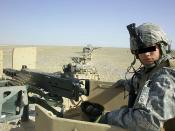Since the war on terrorism begun, food aid packages have been air dropped in Afghanistan to help the starving refugees. But is it really the most sufficient way? It is argued that some help is better then no help. But food agencies as well as the well informed correspondents from the scene criticise this way of delivering food as being inadequate and not getting to those who actually need it.
The main reasons why the air-drops in Afghanistan should be criticised is their inaccuracy. It has been proven by the BBC and CNN correspondents on the ground, as well as the independent analysts that food aid does not get to those refugees who need it most. The provisions are dropped from a distance of up to several kilometres, and the pilots follow the coordinates which they previously obtain from different sources, mostly spy-satellites. The food therefore does not get to the small refugee camps or the ones that are unsettled and tend to roam from place to place.
But they appear to be the ones who need it most.
However, the food does get to the biggest refugee camps in areas such as Kabul, Herat and Bagram, where it is sold on the local markets, or gets arrested by Taliban soldiers. It has even been reported that they use the American aid to feed their own army! Of course some of it does get to the ones in need, but what are they compared to 6 million Afghans presently dependant on help from the West.
U.S. has been asked by international agencies such as Oxfam International, Britain's Islamic Relief, Christian Aid, CAFOD, Tear Fund and ActionAid to halt the bombings for a short period in order to deliver the necessary supplies by land. Trucks can get to the points where support is needed most, but unfortunately they cannot carry as much as a plane can. Therefore much more time is needed to provide the relief this way, but at least it is brought directly to the dying child deep in the mountains and not to the Taliban soldier, whose house could already be full of bags with rice and other supplies with the label "ÃÂUSA' on them.
The U.S. seems to think that air-drops of food supplies preceded by missile bombardment of land targets (including UN and Red Cross buildings, as well as other food storage departments) are good enough to keep up their image. It appears to be almost a perfect war strategy: civilians are killed in the bombardments, but U.S. manages to look kind and caring by providing "charitable aid"ÃÂ. On the other hand different humanitarian organisations struggle to get the food to those who really need it before winter, but without a pause in the bombardment it would hardly be possible.





